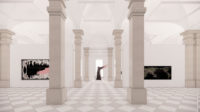This piece was first published on April 24 on ENR.com.
After more than 40 years of chronicling the nation’s storied exploration of the sky and heavens, the Smithsonian Institution’s National Air and Space Museum in Washington, D.C., was, in a word, tired.
Since opening in 1976, the museum has welcomed more than 350 million visitors attracted by exhibits ranging from the Wright Brothers’ original 1903 Flyer to the command module that just 66 years later brought the Apollo 11 astronauts home from the first manned landing on the moon. As the decades passed, however, the iconic building on the National Mall increasingly displayed the effects of age, use and the elements. There was a lengthy list of envelope deficiencies, most notably a deteriorating roof, leaking skylights and a failing curtain wall and facade that also bore the effects of a 2011 earthquake.
The museum’s building systems were nearing the end of their service life as well, making it difficult to reliably maintain consistent interior temperature and humidity. “Without those type of controls,” explains Jim Evans, the Smithsonian’s assistant director for logistics, “it’s difficult to provide the best environment for the artifacts within the building.”
Later this year, the Air and Space Museum will reach substantial completion on a comprehensive, multi-year renovation seemingly as complex as sending humans and probes into space. Led by the construction manager at-risk team of CSC, composed of Clark Construction Group, Smoot Construction and Consigli Construction, the program has encompassed a full replacement of the exterior stone facade, glass curtain wall and skylights and the addition of a tensile roof entrance canopy whose abstract winged shape was inspired by images of the early flying machines developed by Leonardo da Vinci. The team also updated mechanical and electrical systems serving gallery and presentation spaces and performed other building improvements.
The Smithsonian has not disclosed the total cost of the renovation program, which was launched with a $650-million congressional appropriation and augmented by an effort to raise $250 million from private sources for new exhibitions.
Read more from Jim Parsons at RECORD's sister site, ENR.com.



Post a comment to this article
Report Abusive Comment